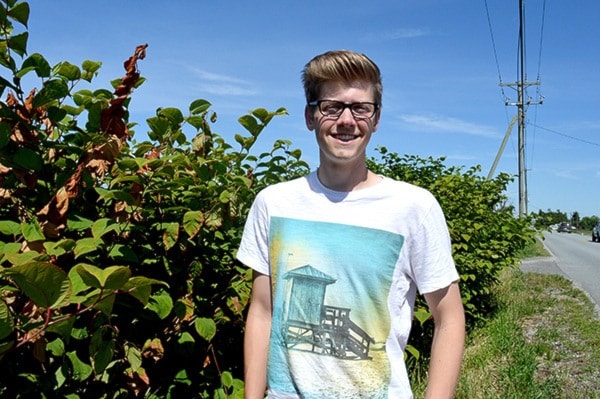Knotweed will not take over British Columbia if Matthew Strelau has anything to say about it.
The Surrey resident is studying whether the invasive bohemian knotweed plant will build up a resistance to the herbicide used to treat it.
Strelau is doing a month-long research project thanks to a $2,000 grant from the Weed Science Society of America.
Across the province, knotweed is treated with the chemical glyphosate, in the brand of weedkiller Round-Up, Strelau explained.
“You can apply it to so many plants, it breaks down easily in the soil, it’s cheap, it’s effective, but when you have only one herbicide you’re applying to one plant throughout the whole province, and this chance of resistance significantly increases,” said Strelau, who attends Trinity Western University.
The concern about resistance building is prudent, he explained, because of a hybrid that’s produced.
“There used to be giant knotweed and we had Japanese knotweed, but the issue now is the two hybridized together,” said Strelau. “Japanese knotweed was growing in local sites, it just couldn’t reproduce sexually, it couldn’t produce seeds, so it couldn’t travel far distances unless we moved it. The issue is that this new one has the ability to produce sexually, so we get aggressive local weeds…. Now, 70 per cent of the knotweed here is the bohemian knotweed.”
 According to the Invasive Species Council of British Columbia, there are no bio-control agents available to control knotweed. While mowing and cutting it can be effective, it must be done repeatedly for five years to exhaust the plant’s roots.
According to the Invasive Species Council of British Columbia, there are no bio-control agents available to control knotweed. While mowing and cutting it can be effective, it must be done repeatedly for five years to exhaust the plant’s roots.
When left alone, the weed spreads quickly along the banks of streams and other water bodies, easily growing to a height of four metres in just two months. It can grow four to eight centimetres a day.
The dangers are twofold, said Strelau.
“First, there’s the ecological side,” he said. “It’s killing out a lot of plants, it’s changing the soil, it’s definitely hurting invertebrates and other things like that. Then the economic standpoint: It’s costing us a lot of money to treat it and it definitely destroys infrastructure. If it’s found on your property, your property value significantly decreases. So it’s a big issue in that sense. It destroys buildings.”
He added the B.C. realty community is pushing for an effective treatment.
Neal Aven, Surrey’s urban forestry and environmental programs manager, said Surrey has a few hundred known invasive plant sites, and that list continues to grow.
The city also works to educate the community, seeing as residents are often the ones depositing invasive species in the first place, he explained.
“One of the ways invasive plants get into our forests are from dumping. People dumping yard waste…. They chuck it over the fence into the forest,” Aven noted.
Last week, the Now reported that some locals were shocked to learn the city was spraying invasive plants with glyphosate.
In 2015, the World Health Organization found it to be “probably carcinogenic” in humans.
Retired Surrey teacher Ken Borrie told the Now while invasive plants like lamium are a nuisance, they are easy to rip out by hand.
SEE MORE: City of Surrey herbicide linked to non-Hodgkin lymphoma
“We would be happy to volunteer,” he said. “No need for chemical warfare.”
But Aven noted that in 2016 the WHO did a follow-up study with the UN’s Food and Agriculture Organization that “clarifies” health issues concerning glyphosate, which is a key ingredient in Roundup, a weedkiller produced by Monsanto.
This latest study concluded the chemical is “unlikely to pose a carcinogenic risk to humans from exposure through the diet.” It did, however, find “some evidence of a positive association between glyphosate exposure and risk of NHL,” or non-Hodgkin lymphoma.
With files from Tom Zytaruk
